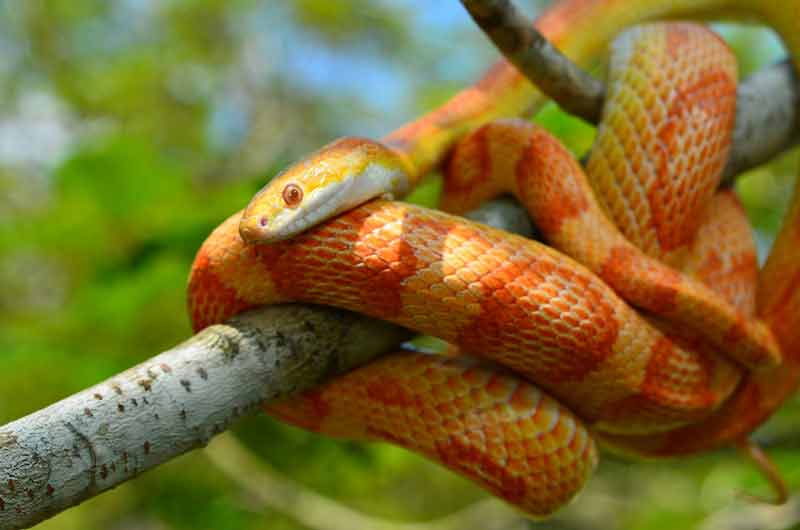Corn snakes are cylindrical, reddish, brownish or yellowish snakes with red or black blotches all over the body. They have a distinctive pattern of alternating white and black marks. These snakes vary considerably in colour and pattern due to different geographical locations.
Corn snakes and copperheads both live as beneficial predators of rodents. However, people find it challenging to make a difference between corn snakes and copperheads. Corn snakes are non-venomous snakes, while copperheads are venomous snakes. Therefore, corn snakes often come under attack because people confuse them with copperheads.
Corn snakes don’t have functional venom and are not harmful to human beings. Instead, they are beneficial to human beings because they decrease the wild rodent population that spread diseases in crops and damages them. Corn snakes are known as red rat snakes because they prey upon rats.
Table of Contents
Milk Snake Vs Corn Snake
Corn snakes and milk snakes are not entirely different from each other. They are very similar in their size, lifespan, habitat and the diet they take. However, you can make differences to identify between both the snakes.
Life Span
Corn snakes and milk snakes have life spans; corn snakes can live six to eighty years in the wild. However, they can live much longer, about twenty years in captivity, if better conditions are provided.
Milk snakes live almost the same years in captivity; they can live for fifteen years in the wild and twenty years in captivity.
Physical Features
Pet owners adore the bright, striking colours and intricate, beautiful patterns of snakes. Corn snakes come in various striking colours and patterns, out of which three colours are most common. These three include orange-yellow, red-orange and black. In addition, their scales have orange shades.
It is not astonishing to find hundreds of different species of corn snakes differing in colour and pattern.
Milk snakes vary in colour and pattern and have smooth and shiny scales. Their colour range is red-black and white-black-red. The colour and pattern of milk snakes are very stunning, and they don’t have many different variants.
King Snake Vs Corn Snake
Life Span And Temperament
Kingsnake and corn snakes grow up to the same length, but king snakes can grow a little bigger. There is no apparent difference in the life span of both the snakes. Both snakes can be perfect pets as both are very docile and easy to handle. Both snakes can grow to a perfect size for a pet. However, king snakes have a problematic attitude that may be because of their eating behaviour. They possess aggressive and eager eating behaviour. Their eager and aggressive behaviour can be problematic because they can attack any moving object that could be their own body. You should be very careful because they can also attack your fingers.
Breeding and Physical Features
Kingsnake and corn snake are easy to breed and therefore have different varieties in colour and pattern. Kingsnake and corn snakes both are easily bred to produce different beautiful and striking coloured snakes.
Corn Snake Vs Ball Python
Corn snakes are hardy snakes, which means that they can easily survive at room temperature. However, ball pythons require to maintain temperature even in the enclosure. Corn snakes and ball pythons grow up to the same length thereby can be a good pets. Ball pythons have larger girth, while corn snakes are thin.
Life Span
Corn snakes and ball pythons both have a longer life span of above fifteen years. But ball pythons can live more up to 20-25 years in captivity. However, there is almost ten years difference in age, but both the snakes are long term commitments.
Ball pythons have different requirements for temperature, humidity and other environmental conditions because of their natural habitat. It means they need additional equipment to maintain a good life in captivity.
Physical Features
Corn snakes have thin bodies and come in various striking colour patterns that are different from ball python. Most of the corn snakes are bright in colour.
While ball pythons have more girth than corn snakes, have diamond shape heads, are less colourful and look different than corn snakes. They don’t possess a wide range of colouration and mostly appear in brown or black.
Both corn snakes and ball pythons are easily manageable, low-maintenance and docile pets. They are a good choice for a first-time pet owner. They don’t grow too big, are social and come in a variety of colourations and patterns. Between these two, a ball python makes a better pet for first-time owners as they are girthy, shy, and reserved pets.
Male Vs Female Corn Snake
Pet owners always ask for the difference in the behaviour of a male and female corn snake. The most common question of a first-time pet owner is whether a male corn snake is better to keep or a female corn snake.
There is no such difference between male and female behaviour. However, you should consider before combining a male and female snake inside one enclosure. Two male snakes inside one enclosure cant make a good deal; they will fight for dominance. If there is one male and one female snake in an enclosure, the male snake will show aggressive behaviour. Two female snakes can make a good deal.
In addition, there is no noticeable difference in shedding, feeding and stress of male and female snakes. However, shedding makes the corn snake feel vulnerable, and corn snakes show aggressive behaviour while feeding. But there is no difference in the behaviour of male and female corn snakes.
Furthermore, both male and female corn snakes are territorial. Experts say that corn snakes own their territories without fighting; the problem can occur if snakes live nearby. However, corn snakes live in their exclusive territory without being a problem to the other.
Core psychology and behavioural pattern of different snakes is almost the same. However, some behavioural differences develop because of environmental differences. Temperature, humidity, feeding and surrounding affects the behaviour and personality of snakes significantly.

